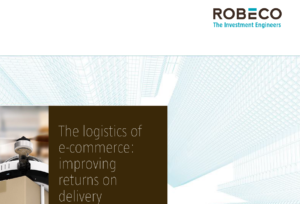A new Robeco report presents investment opportunities in growing e-commerce: warehouse automation providers, prime warehouse owners, software companies. E-commerce is booming, exposing its logistic backbone to an ever increasing bill. The e-commerce sector is therefore trying to find cheaper solutions with the help of innovative tools, such as robots that are learning to see and pick stuff, artificial intelligence, drones and more.
The right industrial real estate at the right location in the network can reduce last-mile cost, improve service and enable fast delivery. As warehouse rental costs are only a small portion of the overall logistics bill, warehouse owners are often able to enjoy substantial rent increases. Robeco therefore see owners of prime industrial real estate assets as major beneficiaries of e-commerce growth.
Warehouse automation
One of our best ways to benefit from growing e-commerce is through warehouse automation. This is crucial for success. One specific automation technology will bring about the inflection point: as robots learn to see through vision technology, they get ready to enter the warehouse.
To be able to work in a warehouse, robots have to learn something new: the perception and recognition of objects. In other words, they have to learn to see. This ‘vision technology’ includes cameras, laser sensors, Radio-frequency RFID devices and barcode readers. They are found along a warehouse’s whole process chain and make sure that hardware can effectively signal to software, or the Warehouse Management System. The producers of these vision systems are among the most interesting investment opportunities related to e-commerce growth.
The holy grail of warehouse automation is picking. Currently, half of all labor time is spent on picking and packing, as 90% of the picks in a warehouse are still done by a human hand. This has been termed Moravec’s paradox: it is very easy to teach robots adult skills but incredibly difficult to let them perform tasks a two-year old already masters – such as picking from a cluttered bin with overlapping items. Nevertheless, we think solving this challenge is possible and will be done through a combination of machine 3D vision and deep learning.
Patchwork solution
As the last mile is the biggest cost item, it is the main battleground for incumbents and start-ups alike. There won’t be a ‘one-size-fits-all-solution’, and we think the last mile will become an ever more fragmented mix of many solutions. Start-up companies will bring technologies such as cloud platforms or crowd sharing to the logistics industry to make clever use of free capacity elsewhere. Incumbents will experiment with automatically guided vehicles (AGVs), drones, self-driving robots or even delivery tunnels. While many sound and probably are far out in the future, others – or at least pre-forms of them – will be with us quite soon.
Barcodes, RFID tags and lasers alike are generating and collecting vast amounts of data – which are worth nothing unless turned into insights for better decision-making. This is the domain of software companies offering (inter)-enterprise software for supply chain management. With the help of cloud solutions and artificial intelligence, logistics can become just-in-time and efficient.
Industrial innovation to upgrade e-commerce
While e-commerce introduces a lot of challenges to logistics, ‘Industry 4.0’ brings a lot of tools to offset costs in what has historically been a low-tech and often very inefficient industry. Connecting the supply chain from one end to the other will significantly benefit suppliers of Automatic Data Capture devices, including sensors, lasers, connectors, cameras and tags. Asset owners will enjoy better utilization rates and, last but not least, the environment will benefit from lower emissions.
Source: Robeco

